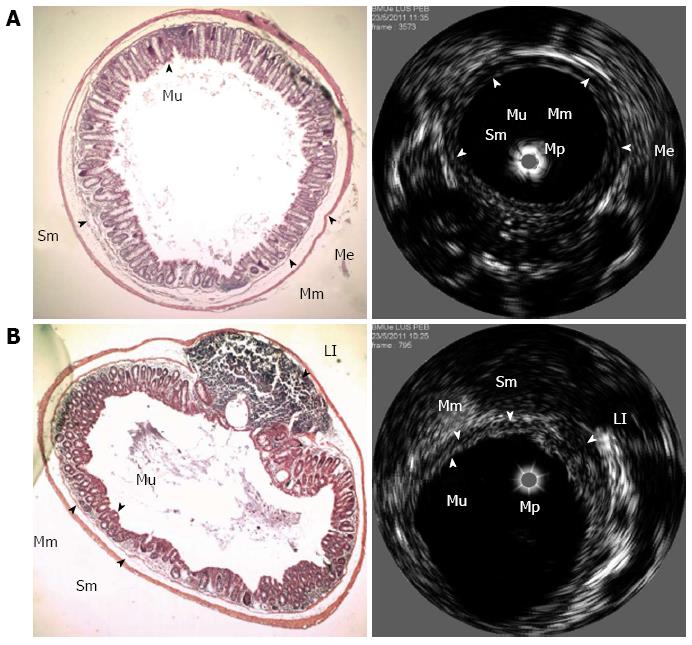Copyright
©2013 Baishideng Publishing Group Co.
World J Gastroenterol. Nov 28, 2013; 19(44): 8056-8064
Published online Nov 28, 2013. doi: 10.3748/wjg.v19.i44.8056
Published online Nov 28, 2013. doi: 10.3748/wjg.v19.i44.8056
Figure 2 Correlation between endoluminal ultrasonic biomicroscopy and histological images.
A: Endoluminal ultrasonic biomicroscopy (eUBM) (right) and the corresponding hematoxylin and eosin-stained histological section (left, × 40 magnification) obtained from a healthy region of a mouse colon. The eUBM image displays two hyperechoic layers: mucosa (Mu) and submucosa (Sm) and two hypoechoic layers: muscularis mucosae (Mm) and muscularis externa (Me). The ultrasound catheter mini-probe (Mp) is at the center of the lumen; B: eUBM (right) and the corresponding hematoxylin and eosin-stained histological section (left, × 40 magnification) obtained from a mouse colon containing a lymphoid infiltrate in the colonic wall. The eUBM image displays the mucosa (Mu), muscularis mucosae (Mm) and submucosa layer (Sm). The lymphoid infiltrate (LI) lesion is seen as a hypoechoic region underneath the mucosa. The ultrasound catheter mini-probe (Mp) is at the center. All layers identified in the ultrasound images are well correlated with the histological images from the same site.
- Citation: Soletti RC, Alves KZ, Britto MA, Matos DG, Soldan M, Borges HL, Machado JC. Simultaneous follow-up of mouse colon lesions by colonoscopy and endoluminal ultrasound biomicroscopy. World J Gastroenterol 2013; 19(44): 8056-8064
- URL: https://www.wjgnet.com/1007-9327/full/v19/i44/8056.htm
- DOI: https://dx.doi.org/10.3748/wjg.v19.i44.8056









